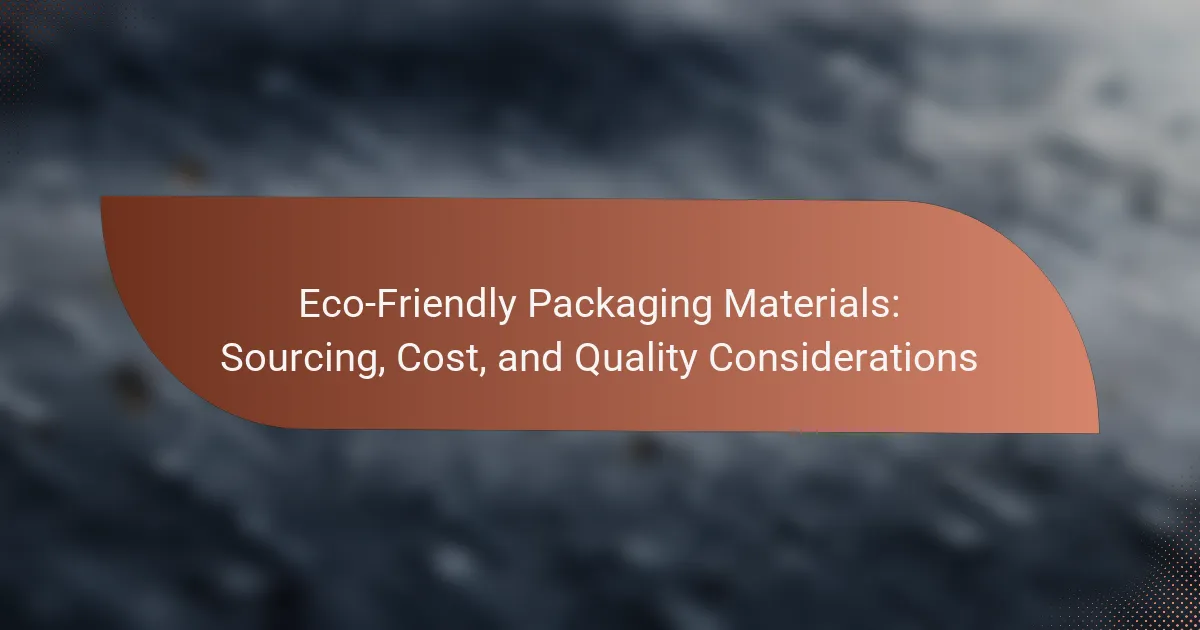In today’s environmentally conscious market, selecting eco-friendly packaging materials is essential for e-commerce businesses. Options such as biodegradable plastics, recycled paper, and compostable materials not only reduce environmental impact but also come with various sourcing, cost, and quality considerations. By prioritizing sustainable suppliers and understanding the financial implications, businesses can effectively balance their packaging needs with their commitment to sustainability.

What are the best eco-friendly packaging materials for e-commerce?
The best eco-friendly packaging materials for e-commerce include biodegradable plastics, recycled paper, compostable materials, glass containers, and plant-based films. Each option offers unique benefits and considerations regarding sourcing, cost, and quality.
Biodegradable plastics
Biodegradable plastics are designed to break down more quickly than traditional plastics, typically within a few months to a couple of years, depending on environmental conditions. They are often made from renewable resources like corn starch or sugarcane, making them a more sustainable choice for packaging.
When sourcing biodegradable plastics, consider certifications such as ASTM D6400 or EN 13432, which ensure they meet specific composting standards. While they can be more expensive than conventional plastics, their environmental benefits may justify the cost for eco-conscious brands.
Recycled paper
Recycled paper is made from post-consumer waste and is a popular choice for packaging due to its low environmental impact. It can be used for boxes, mailers, and void fill, making it versatile for various e-commerce needs.
When choosing recycled paper, look for products with a high percentage of recycled content, ideally over 50%. This not only reduces waste but also lowers the demand for virgin materials, contributing to a circular economy.
Compostable materials
Compostable materials are designed to break down into natural elements in a composting environment, typically within 90 to 180 days. These materials can include bioplastics, paper, and plant-based substances, offering an eco-friendly alternative to traditional packaging.
For effective composting, ensure that the materials are certified compostable, such as those meeting the ASTM D6868 standard. While they may carry a higher price tag than conventional options, the environmental benefits can enhance brand reputation and customer loyalty.
Glass containers
Glass containers are a durable and reusable option for packaging, particularly for products like cosmetics, food, and beverages. They are 100% recyclable and can be recycled indefinitely without losing quality, making them a sustainable choice.
However, glass packaging can be heavier and more fragile than other materials, potentially increasing shipping costs and the risk of breakage. Brands should weigh these factors against the benefits of using glass to align with their sustainability goals.
Plant-based films
Plant-based films are derived from renewable resources such as corn or potatoes and serve as an alternative to conventional plastic films. These films are often used for wrapping and sealing products, providing a barrier against moisture and oxygen while being more environmentally friendly.
When selecting plant-based films, check for certifications that indicate they are biodegradable or compostable. Although they may come at a premium compared to traditional films, their reduced environmental impact can appeal to eco-conscious consumers.
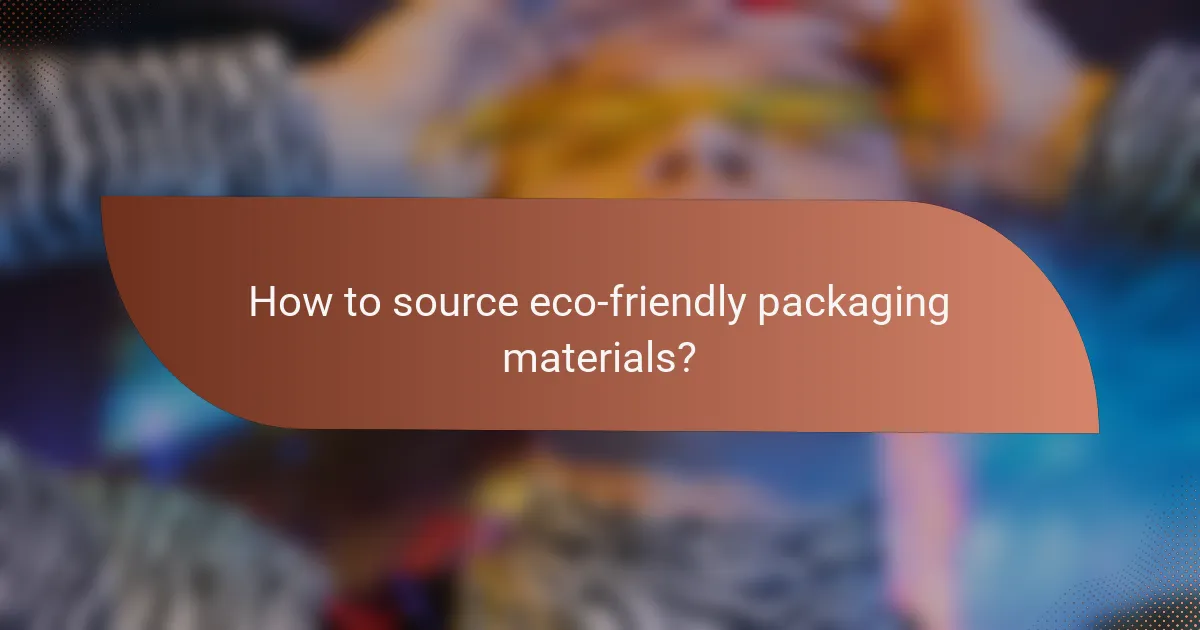
How to source eco-friendly packaging materials?
Sourcing eco-friendly packaging materials involves identifying suppliers that prioritize sustainability and environmentally friendly practices. Consider local suppliers, online marketplaces, and sustainable brands to find options that meet your quality and cost requirements.
Local suppliers
Local suppliers can provide eco-friendly packaging materials that reduce transportation emissions and support the community. Look for businesses that specialize in sustainable products, such as biodegradable plastics or recycled paper. Engaging with local suppliers often allows for better communication and customization options.
When sourcing locally, consider visiting trade shows or local business directories to discover potential partners. Establishing relationships with these suppliers can lead to better pricing and terms, especially for bulk orders.
Online marketplaces
Online marketplaces offer a wide range of eco-friendly packaging materials from various suppliers, making it easy to compare options. Websites like Amazon, Etsy, or specialized eco-friendly platforms allow you to filter products based on sustainability certifications and customer reviews.
When using online marketplaces, pay attention to shipping costs and delivery times, as these can impact your overall expenses. Check for bulk purchase discounts and ensure that the materials meet your quality standards before placing an order.
Sustainable brands
Sustainable brands focus on producing eco-friendly packaging materials with a commitment to environmental responsibility. Companies like Eco-Products and Biopak offer a variety of options, from compostable containers to recyclable wraps, often with clear information on their sourcing and production processes.
Research these brands to understand their certifications, such as FSC or Cradle to Cradle, which indicate adherence to sustainability standards. Investing in products from reputable sustainable brands can enhance your brand’s image while ensuring you meet eco-friendly goals.
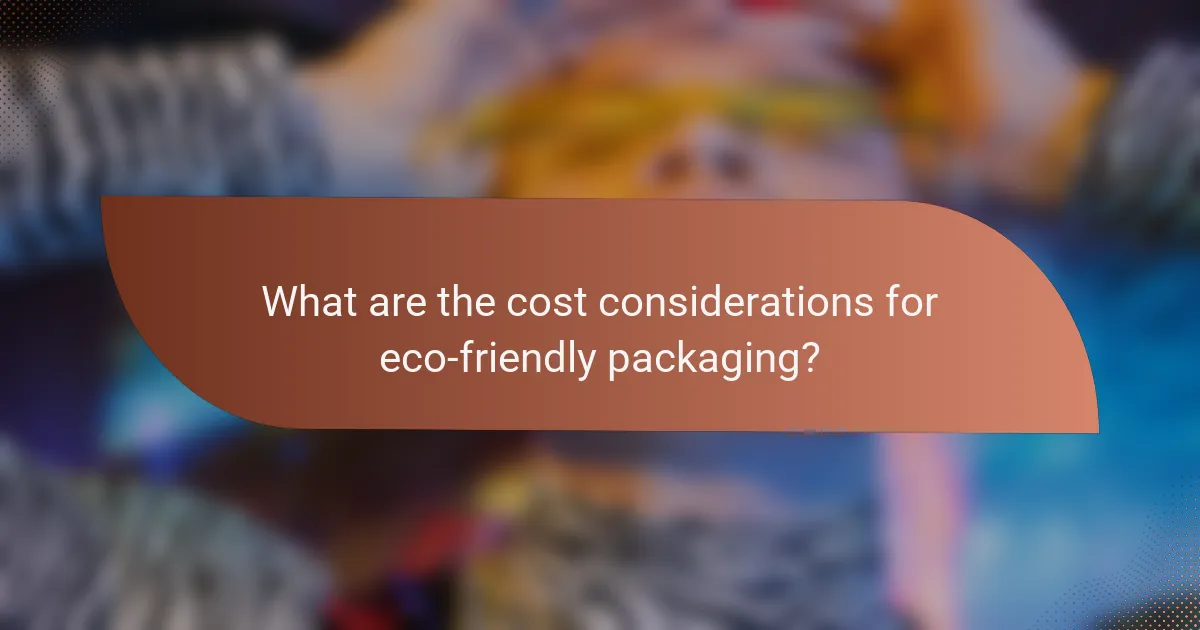
What are the cost considerations for eco-friendly packaging?
Cost considerations for eco-friendly packaging include material costs, shipping expenses, and potential savings from bulk purchasing. Understanding these factors helps businesses budget effectively while maintaining sustainability goals.
Material costs
Material costs for eco-friendly packaging can vary significantly based on the type of materials used, such as biodegradable plastics, recycled paper, or plant-based options. Generally, these materials may be more expensive than traditional packaging, often ranging from 10% to 50% higher, depending on the supplier and material quality.
When selecting materials, consider not only the upfront costs but also the long-term benefits, such as brand reputation and customer loyalty. Investing in high-quality eco-friendly materials can enhance perceived value and attract environmentally conscious consumers.
Shipping expenses
Shipping expenses for eco-friendly packaging can be influenced by the weight and volume of the materials. Lightweight and compact packaging options can reduce shipping costs, making them more economical in the long run. However, some eco-friendly materials may be bulkier, potentially increasing shipping fees.
It’s important to evaluate shipping options and choose carriers that prioritize sustainability, as they may offer better rates for eco-friendly products. Additionally, consider local sourcing to minimize transportation costs and carbon footprint.
Bulk purchasing discounts
Bulk purchasing discounts can significantly lower the overall cost of eco-friendly packaging. Many suppliers offer reduced rates for larger orders, which can help businesses save money while committing to sustainable practices. Discounts can range from 5% to 20%, depending on the supplier and order size.
To maximize savings, plan ahead and assess your packaging needs to determine optimal order quantities. Establishing long-term relationships with suppliers can also lead to better pricing and exclusive deals on eco-friendly materials.
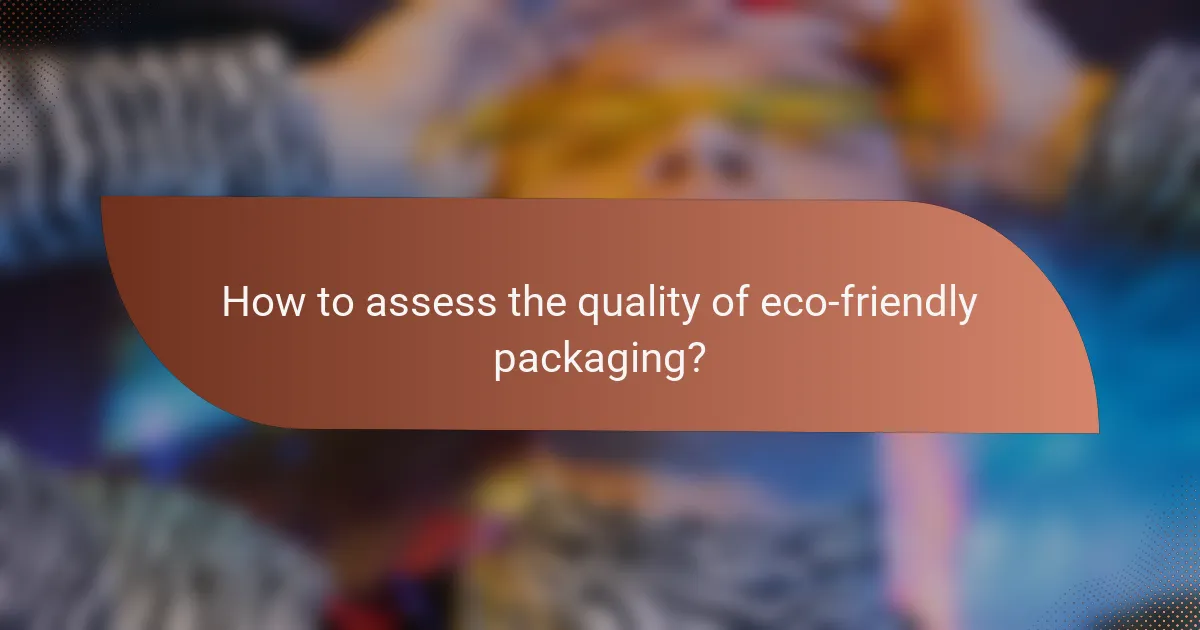
How to assess the quality of eco-friendly packaging?
Assessing the quality of eco-friendly packaging involves evaluating its durability, compliance with certification standards, and feedback from suppliers. These factors ensure that the packaging not only meets environmental criteria but also performs effectively in its intended use.
Durability tests
Durability tests are crucial for determining how well eco-friendly packaging can withstand various conditions during transportation and storage. Common tests include drop tests, compression tests, and moisture resistance evaluations. For instance, packaging should ideally endure impacts without compromising its integrity, maintaining functionality even in humid environments.
When evaluating durability, consider the materials used. Biodegradable plastics may not perform as well as traditional plastics in certain scenarios, so understanding the specific application is essential. Aim for packaging that meets industry standards for durability, which can vary based on the product type.
Certification standards
Certification standards help verify that eco-friendly packaging meets specific environmental and safety criteria. Look for certifications such as FSC (Forest Stewardship Council) for paper products, or compostability certifications like ASTM D6400 for bioplastics. These certifications provide assurance that the materials are sourced sustainably and will break down in an environmentally friendly manner.
Understanding the relevant certifications for your region can also guide your choices. For example, in the European Union, compliance with EN 13432 is important for packaging to be labeled as compostable. Familiarize yourself with local regulations to ensure compliance and enhance your brand’s credibility.
Supplier reviews
Supplier reviews are a valuable resource for assessing the quality of eco-friendly packaging. Look for feedback on the supplier’s reliability, product quality, and customer service. Online platforms and industry forums often provide insights from other businesses that have used the supplier’s products.
When evaluating suppliers, consider reaching out for samples to test the packaging yourself. This hands-on approach allows you to assess the quality directly and ensures that the packaging meets your specific needs. Additionally, check for long-term partnerships and repeat customers, as these can indicate a supplier’s reliability and product consistency.
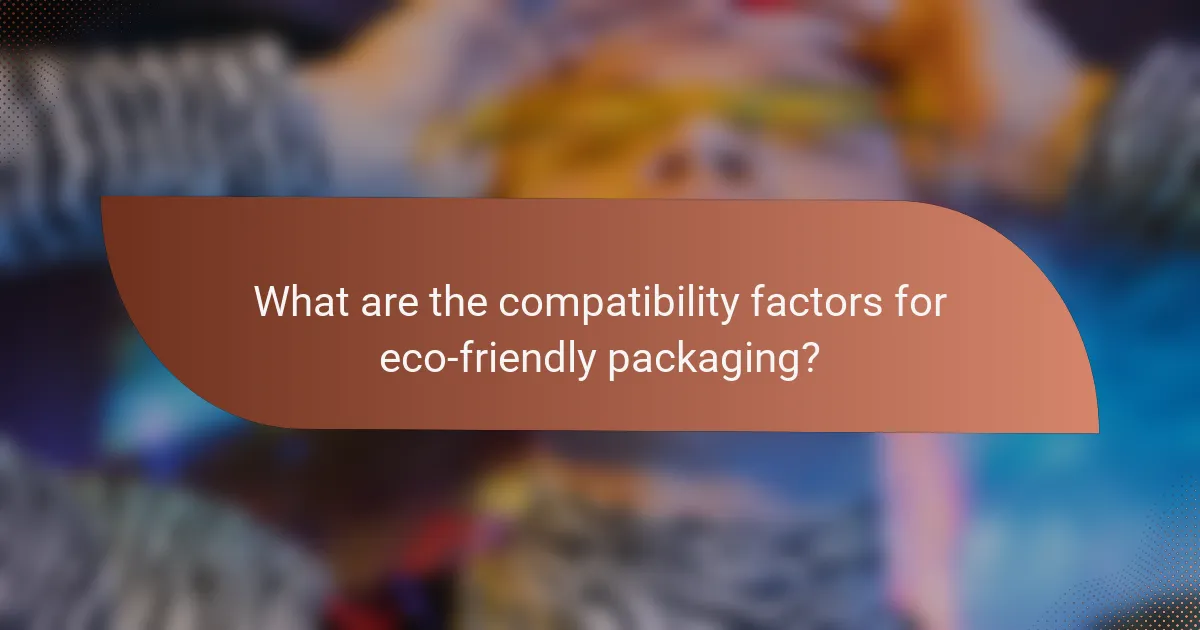
What are the compatibility factors for eco-friendly packaging?
Compatibility factors for eco-friendly packaging include the material’s suitability for the product, its environmental impact, and its ability to maintain product integrity. Evaluating these factors ensures that the packaging not only protects the product but also aligns with sustainability goals.
Product type
The type of product significantly influences the choice of eco-friendly packaging materials. For instance, perishable goods often require materials that offer moisture resistance and barrier properties, while non-perishable items may prioritize recyclability or biodegradability. Understanding the specific needs of the product helps in selecting the most compatible packaging solution.
For example, food products might benefit from compostable films or biodegradable containers, while electronics may require recycled cardboard or paper that provides adequate protection without compromising sustainability. Evaluating the product’s characteristics is essential in determining the right packaging type.
